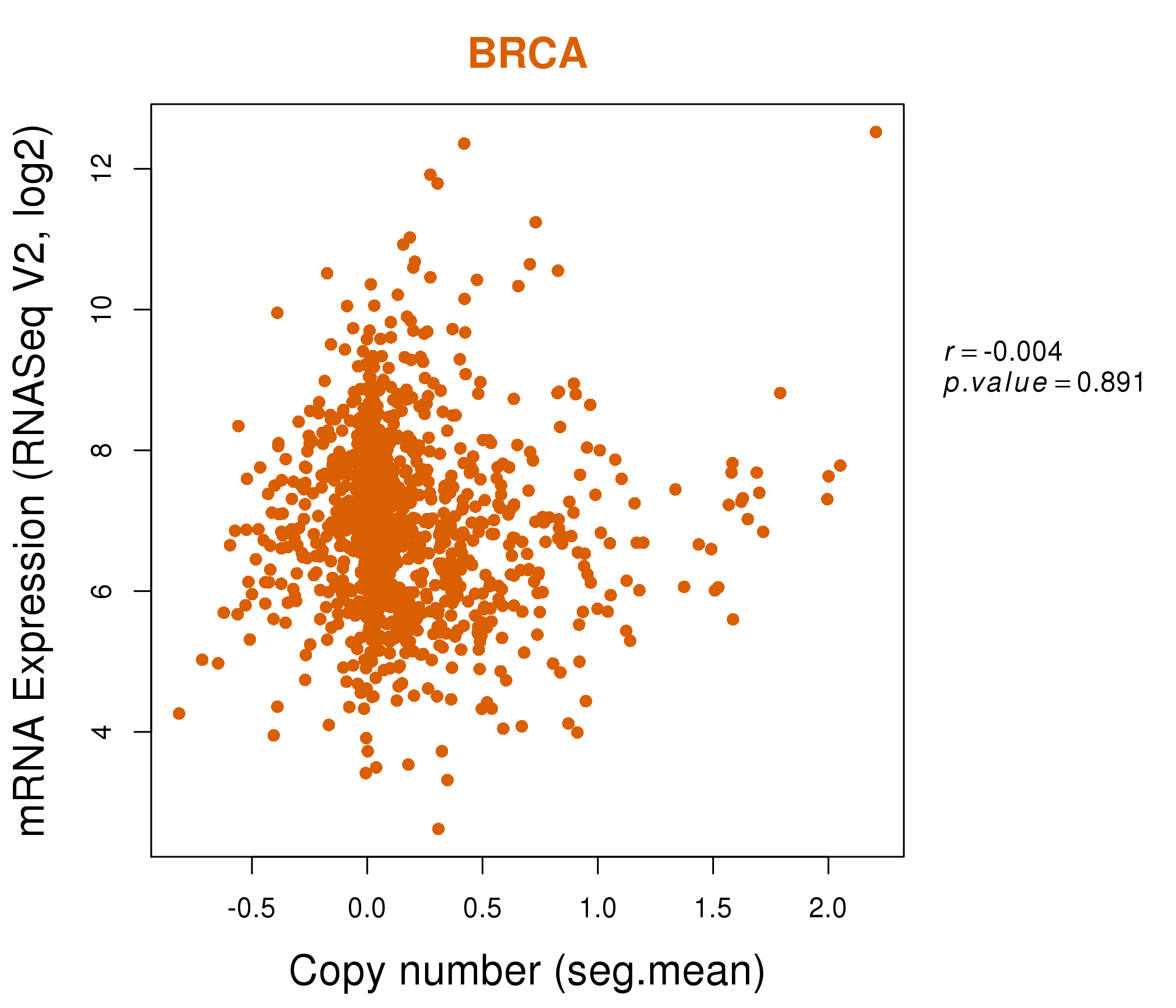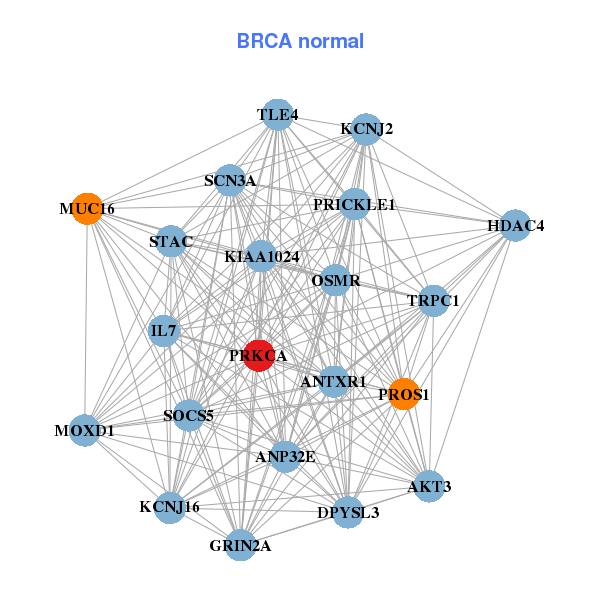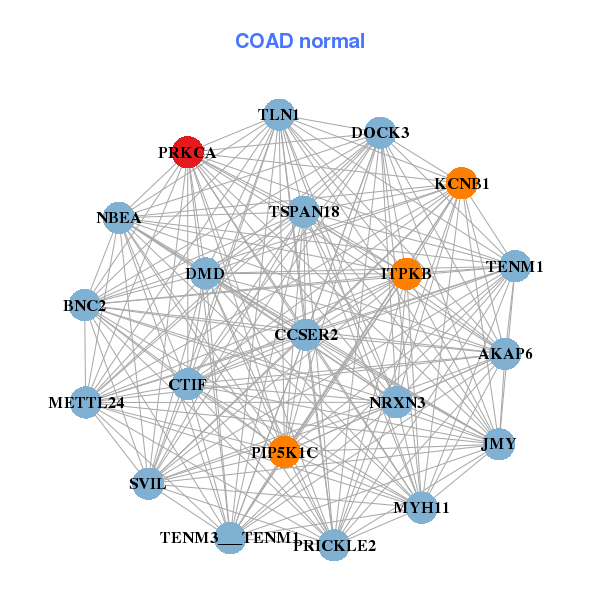|
|||||||||||||||||||||||||||||||||||||||||||||||||||||||||||||||||||||||||||||||||||||||||||||||||||||||||||||||||||||||||||||||||||||||||||||||||||||||||||||||||||||||||||||||||||||||||||||||||||||||||||||||||||||||||||||||||||||||||||||||||||||||||||||||||||||||||||||||||||||||||||||||||||||||||||||||||||||||||||||||||||||||||||||||||||||||||||||||||||||||||||||||||||||||||||||||||||||||||||||||||||||||||||||||||||||||||||||||
| |
| Phenotypic Information (metabolism pathway, cancer, disease, phenome) |
| |
| |
| Gene-Gene Network Information: Co-Expression Network, Interacting Genes & KEGG |
| |
|
| Gene Summary for PRKCA |
| Top |
| Phenotypic Information for PRKCA(metabolism pathway, cancer, disease, phenome) |
| Cancer | CGAP: PRKCA |
| Familial Cancer Database: PRKCA | |
| * This gene is included in those cancer gene databases. |
|
|
|
|
|
| . | |||||||||||||||||||||||||||||||||||||||||||||||||||||||||||||||||||||||||||||||||||||||||||||||||||||||||||||||||||||||||||||||||||||||||||||||||||||||||||||||||||||||||||||||||||||||||||||||||||||||||||||||||||||||||||||||||||||||||||||||||||||||||||||||||||||||||||||||||||||||||||||||||||||||||||||||||||||||||||||||||||||||||||||||||||||||||||||||||||||||||||||||||||||||||||||||||||||||||||||||||||||||||||||||||||||||||
Oncogene 1 | Significant driver gene in | ||||||||||||||||||||||||||||||||||||||||||||||||||||||||||||||||||||||||||||||||||||||||||||||||||||||||||||||||||||||||||||||||||||||||||||||||||||||||||||||||||||||||||||||||||||||||||||||||||||||||||||||||||||||||||||||||||||||||||||||||||||||||||||||||||||||||||||||||||||||||||||||||||||||||||||||||||||||||||||||||||||||||||||||||||||||||||||||||||||||||||||||||||||||||||||||||||||||||||||||||||||||||||||||||||||||||||||||
| cf) number; DB name 1 Oncogene; http://nar.oxfordjournals.org/content/35/suppl_1/D721.long, 2 Tumor Suppressor gene; https://bioinfo.uth.edu/TSGene/, 3 Cancer Gene Census; http://www.nature.com/nrc/journal/v4/n3/abs/nrc1299.html, 4 CancerGenes; http://nar.oxfordjournals.org/content/35/suppl_1/D721.long, 5 Network of Cancer Gene; http://ncg.kcl.ac.uk/index.php, 1Therapeutic Vulnerabilities in Cancer; http://cbio.mskcc.org/cancergenomics/statius/ |
| KEGG_FC_GAMMA_R_MEDIATED_PHAGOCYTOSIS REACTOME_INTEGRATION_OF_ENERGY_METABOLISM REACTOME_METABOLISM_OF_MRNA REACTOME_METABOLISM_OF_RNA | |
| OMIM | 176960; gene. |
| Orphanet | |
| Disease | KEGG Disease: PRKCA |
| MedGen: PRKCA (Human Medical Genetics with Condition) | |
| ClinVar: PRKCA | |
| Phenotype | MGI: PRKCA (International Mouse Phenotyping Consortium) |
| PhenomicDB: PRKCA | |
| Mutations for PRKCA |
| * Under tables are showing count per each tissue to give us broad intuition about tissue specific mutation patterns.You can go to the detailed page for each mutation database's web site. |
| - Statistics for Tissue and Mutation type | Top |
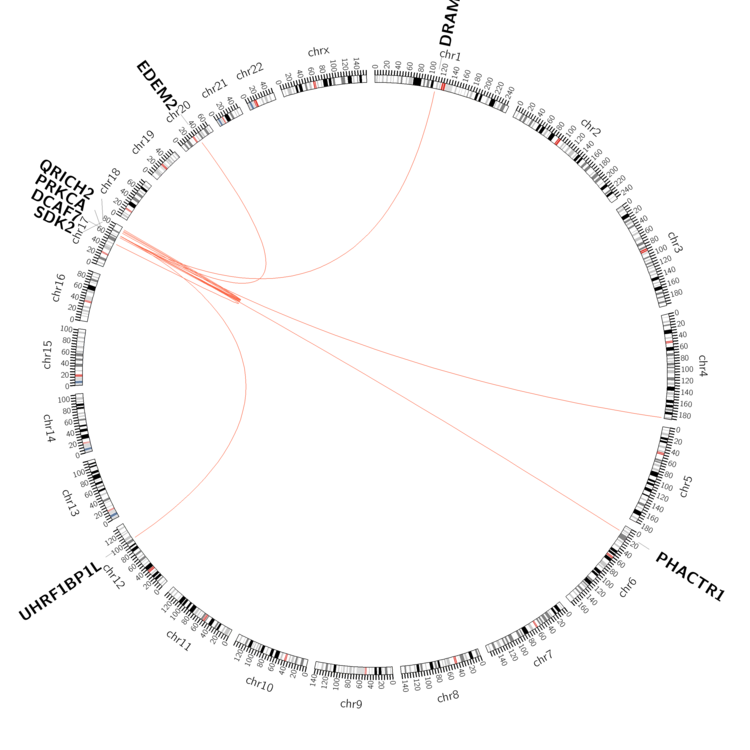 |
| - For Inter-chromosomal Variations |
| * Inter-chromosomal variantions includes 'interchromosomal amplicon to amplicon', 'interchromosomal amplicon to non-amplified dna', 'interchromosomal insertion', 'Interchromosomal unknown type'. |
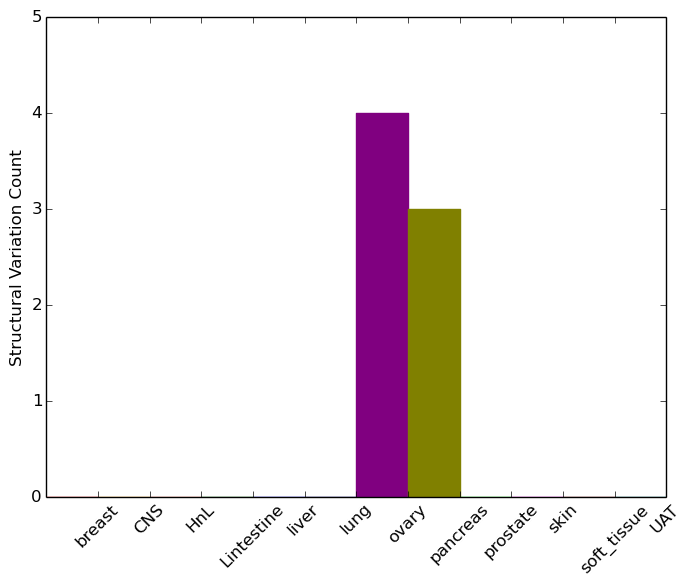 |
| - For Intra-chromosomal Variations |
| * Intra-chromosomal variantions includes 'intrachromosomal amplicon to amplicon', 'intrachromosomal amplicon to non-amplified dna', 'intrachromosomal deletion', 'intrachromosomal fold-back inversion', 'intrachromosomal inversion', 'intrachromosomal tandem duplication', 'Intrachromosomal unknown type', 'intrachromosomal with inverted orientation', 'intrachromosomal with non-inverted orientation'. |
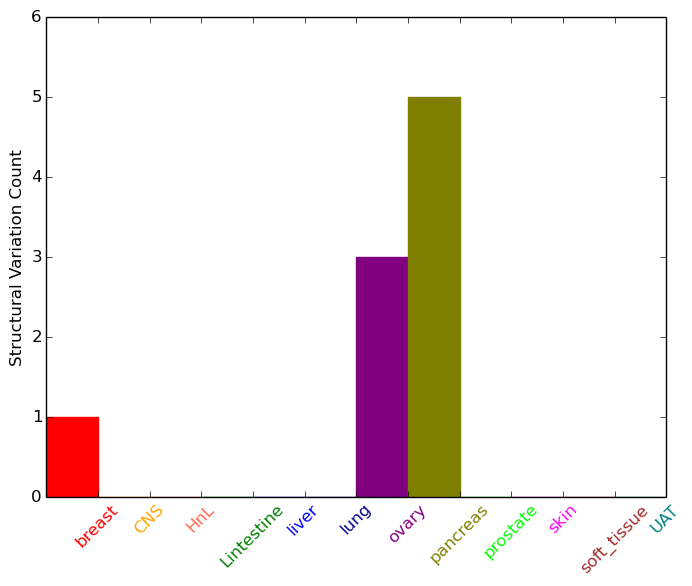 |
| Sample | Symbol_a | Chr_a | Start_a | End_a | Symbol_b | Chr_b | Start_b | End_b |
| breast | PRKCA | chr17 | 64426563 | 64426563 | CARD14 | chr17 | 78173073 | 78173073 |
| NS | PRKCA | chr17 | 64625760 | 64625760 | SDK2 | chr17 | 71433202 | 71433202 |
| ovary | PRKCA | chr17 | 64323211 | 64323231 | PRKCA | chr17 | 64329335 | 64329355 |
| ovary | PRKCA | chr17 | 64431023 | 64431043 | PRKCA | chr17 | 64439985 | 64440005 |
| ovary | PRKCA | chr17 | 64585967 | 64585987 | PRKCA | chr17 | 64589784 | 64589804 |
| ovary | PRKCA | chr17 | 64589749 | 64589769 | UHRF1BP1L | chr12 | 100449860 | 100449880 |
| ovary | PRKCA | chr17 | 64784501 | 64784521 | chr4 | 190179231 | 190179251 | |
| pancreas | PRKCA | chr17 | 64354257 | 64354277 | PRKCA | chr17 | 64356707 | 64356727 |
| pancreas | PRKCA | chr17 | 64354772 | 64354792 | DCAF7 | chr17 | 61629388 | 61629408 |
| pancreas | PRKCA | chr17 | 64355762 | 64355782 | QRICH2 | chr17 | 74275749 | 74275769 |
| pancreas | PRKCA | chr17 | 64390214 | 64390234 | chr17 | 75863079 | 75863099 | |
| pancreas | PRKCA | chr17 | 64477847 | 64477867 | chr17 | 47640527 | 47640547 |
| cf) Tissue number; Tissue name (1;Breast, 2;Central_nervous_system, 3;Haematopoietic_and_lymphoid_tissue, 4;Large_intestine, 5;Liver, 6;Lung, 7;Ovary, 8;Pancreas, 9;Prostate, 10;Skin, 11;Soft_tissue, 12;Upper_aerodigestive_tract) |
| * From mRNA Sanger sequences, Chitars2.0 arranged chimeric transcripts. This table shows PRKCA related fusion information. |
| ID | Head Gene | Tail Gene | Accession | Gene_a | qStart_a | qEnd_a | Chromosome_a | tStart_a | tEnd_a | Gene_a | qStart_a | qEnd_a | Chromosome_a | tStart_a | tEnd_a |
| BF854872 | PRKCA | 1 | 140 | 17 | 64571808 | 64571947 | SLC45A3 | 136 | 310 | 1 | 205633006 | 205633180 | |
| M12996 | G6PD | 1 | 1671 | X | 153759627 | 153763408 | PRKCA | 1664 | 2439 | 17 | 64806066 | 64806841 | |
| L13387 | PRKCA | 1 | 682 | 17 | 64410407 | 64411088 | PAFAH1B1 | 683 | 2749 | 17 | 2570340 | 2586175 | |
| AK098118 | PRKCA | 1 | 2037 | 17 | 64682637 | 64684673 | LYZ | 2032 | 2662 | 12 | 69747383 | 69748013 | |
| BG998534 | PRKCA | 26 | 267 | 17 | 64327025 | 64327270 | PBX1 | 260 | 400 | 1 | 164712457 | 164712597 | |
| CV427033 | PRKCA | 1 | 236 | 17 | 64690984 | 64691219 | ATP2A2 | 228 | 405 | 12 | 110759445 | 110759622 | |
| BF665493 | PRKCA | 1 | 387 | 17 | 64511411 | 64511798 | GALNT13 | 368 | 394 | 2 | 154989282 | 154989308 | |
| BF815383 | ALG5 | 4 | 306 | 13 | 37524095 | 37539828 | PRKCA | 306 | 486 | 17 | 64524798 | 64524978 | |
| Top |
| Mutation type/ Tissue ID | brca | cns | cerv | endome | haematopo | kidn | Lintest | liver | lung | ns | ovary | pancre | prost | skin | stoma | thyro | urina | |||
| Total # sample | 25 | 2 | 2 | 1 | 5 | 1 | 1 | 1 | 1 | 1 | ||||||||||
| GAIN (# sample) | 24 | 2 | 2 | 1 | 2 | 1 | 1 | 1 | 1 | |||||||||||
| LOSS (# sample) | 1 | 3 | 1 |
| cf) Tissue ID; Tissue type (1; Breast, 2; Central_nervous_system, 3; Cervix, 4; Endometrium, 5; Haematopoietic_and_lymphoid_tissue, 6; Kidney, 7; Large_intestine, 8; Liver, 9; Lung, 10; NS, 11; Ovary, 12; Pancreas, 13; Prostate, 14; Skin, 15; Stomach, 16; Thyroid, 17; Urinary_tract) |
| Top |
|
 |
| Top |
| Stat. for Non-Synonymous SNVs (# total SNVs=62) | (# total SNVs=30) |
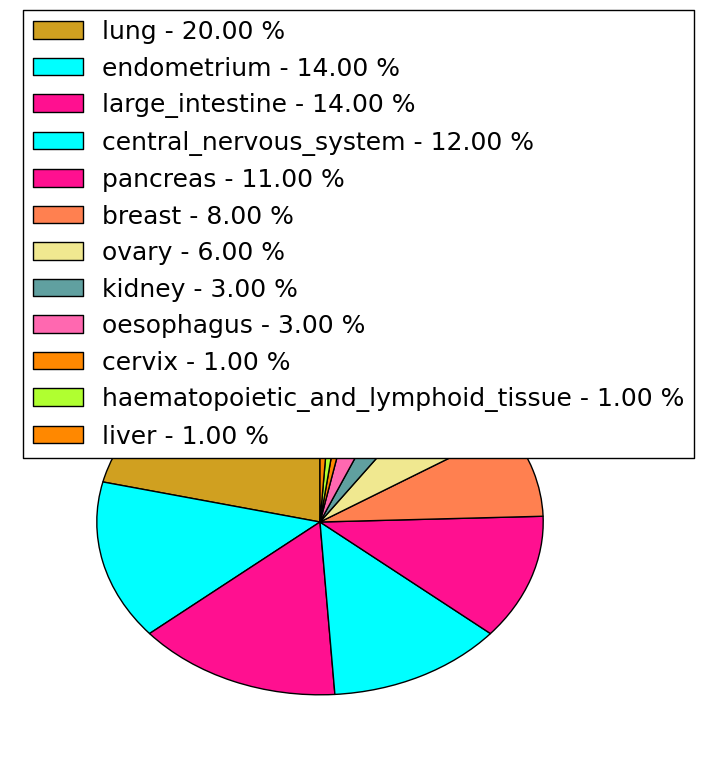 | 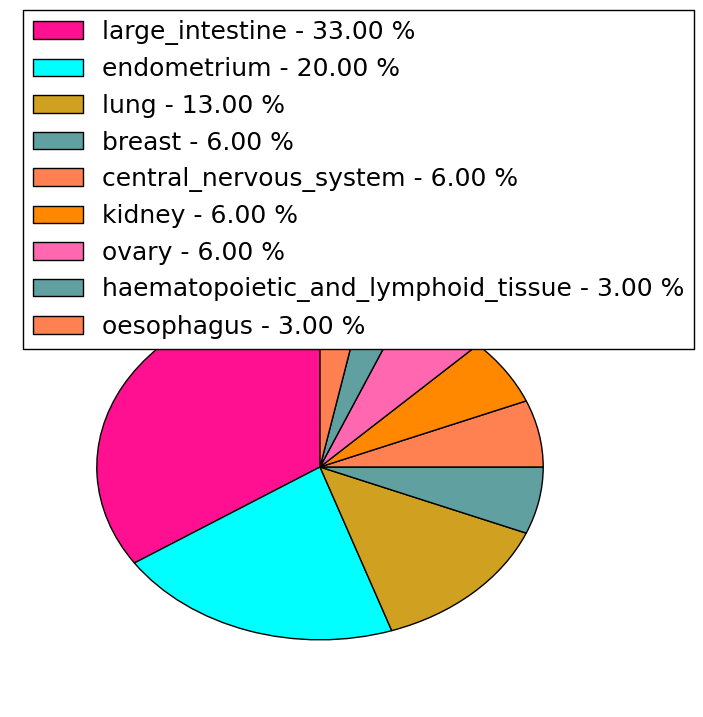 |
(# total SNVs=2) | (# total SNVs=0) |
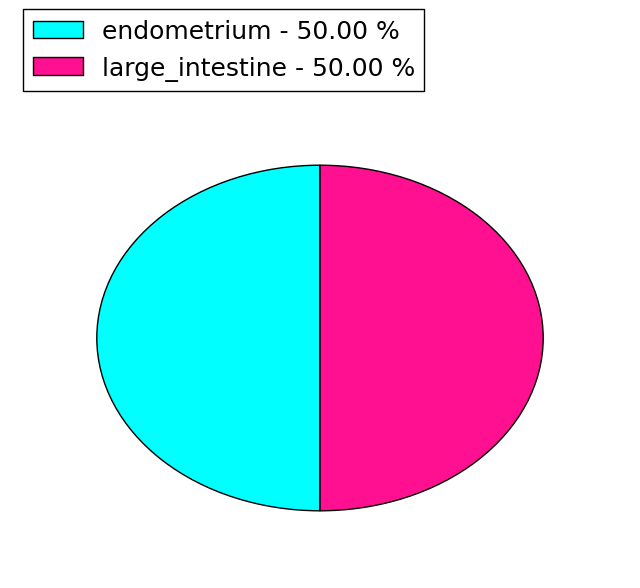 |
| Top |
| * When you move the cursor on each content, you can see more deailed mutation information on the Tooltip. Those are primary_site,primary_histology,mutation(aa),pubmedID. |
| GRCh37 position | Mutation(aa) | Unique sampleID count |
| chr17:64738759-64738759 | p.V469I | 4 |
| chr17:64785022-64785022 | p.E593E | 3 |
| chr17:64637478-64637478 | p.P98P | 3 |
| chr17:64734896-64734896 | p.F415F | 2 |
| chr17:64302236-64302236 | p.Q66* | 2 |
| chr17:64783070-64783070 | p.E564G | 2 |
| chr17:64683239-64683239 | p.N182fs*2 | 2 |
| chr17:64492367-64492367 | p.S85F | 2 |
| chr17:64685078-64685078 | p.L277L | 2 |
| chr17:64641554-64641554 | p.G152R | 2 |
| Top |
|
 |
| Point Mutation/ Tissue ID | 1 | 2 | 3 | 4 | 5 | 6 | 7 | 8 | 9 | 10 | 11 | 12 | 13 | 14 | 15 | 16 | 17 | 18 | 19 | 20 |
| # sample | 2 | 1 | 13 | 2 | 3 | 2 | 11 | 5 | 2 | 11 | 4 | 12 | ||||||||
| # mutation | 2 | 1 | 11 | 2 | 3 | 2 | 12 | 5 | 2 | 11 | 4 | 14 | ||||||||
| nonsynonymous SNV | 1 | 1 | 6 | 2 | 2 | 7 | 5 | 1 | 8 | 3 | 9 | |||||||||
| synonymous SNV | 1 | 5 | 1 | 2 | 5 | 1 | 3 | 1 | 5 |
| cf) Tissue ID; Tissue type (1; BLCA[Bladder Urothelial Carcinoma], 2; BRCA[Breast invasive carcinoma], 3; CESC[Cervical squamous cell carcinoma and endocervical adenocarcinoma], 4; COAD[Colon adenocarcinoma], 5; GBM[Glioblastoma multiforme], 6; Glioma Low Grade, 7; HNSC[Head and Neck squamous cell carcinoma], 8; KICH[Kidney Chromophobe], 9; KIRC[Kidney renal clear cell carcinoma], 10; KIRP[Kidney renal papillary cell carcinoma], 11; LAML[Acute Myeloid Leukemia], 12; LUAD[Lung adenocarcinoma], 13; LUSC[Lung squamous cell carcinoma], 14; OV[Ovarian serous cystadenocarcinoma ], 15; PAAD[Pancreatic adenocarcinoma], 16; PRAD[Prostate adenocarcinoma], 17; SKCM[Skin Cutaneous Melanoma], 18:STAD[Stomach adenocarcinoma], 19:THCA[Thyroid carcinoma], 20:UCEC[Uterine Corpus Endometrial Carcinoma]) |
| Top |
| * We represented just top 10 SNVs. When you move the cursor on each content, you can see more deailed mutation information on the Tooltip. Those are primary_site, primary_histology, mutation(aa), pubmedID. |
| Genomic Position | Mutation(aa) | Unique sampleID count |
| chr17:64637478 | p.E33Q | 3 |
| chr17:64299066 | p.P98P | 3 |
| chr17:64685162 | p.D116N | 2 |
| chr17:64728899 | p.F305F | 2 |
| chr17:64637530 | p.D338N | 2 |
| chr17:64734896 | p.G152R | 2 |
| chr17:64641554 | p.F415F | 2 |
| chr17:64684503 | p.G257V | 1 |
| chr17:64800059 | p.D503G | 1 |
| chr17:64492393 | p.D641D | 1 |
| * Copy number data were extracted from TCGA using R package TCGA-Assembler. The URLs of all public data files on TCGA DCC data server were gathered on Jan-05-2015. Function ProcessCNAData in TCGA-Assembler package was used to obtain gene-level copy number value which is calculated as the average copy number of the genomic region of a gene. |
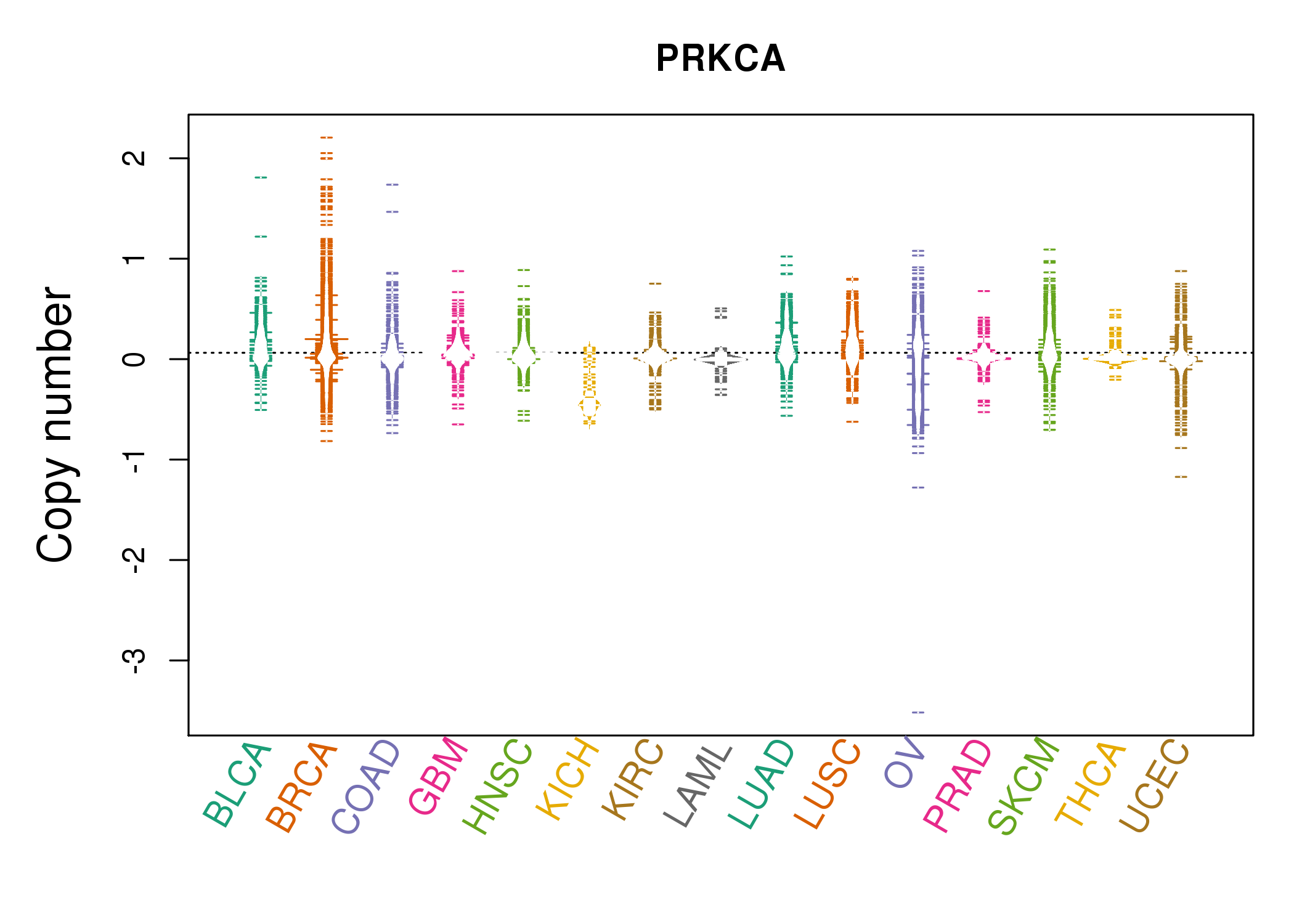 |
| cf) Tissue ID[Tissue type]: BLCA[Bladder Urothelial Carcinoma], BRCA[Breast invasive carcinoma], CESC[Cervical squamous cell carcinoma and endocervical adenocarcinoma], COAD[Colon adenocarcinoma], GBM[Glioblastoma multiforme], Glioma Low Grade, HNSC[Head and Neck squamous cell carcinoma], KICH[Kidney Chromophobe], KIRC[Kidney renal clear cell carcinoma], KIRP[Kidney renal papillary cell carcinoma], LAML[Acute Myeloid Leukemia], LUAD[Lung adenocarcinoma], LUSC[Lung squamous cell carcinoma], OV[Ovarian serous cystadenocarcinoma ], PAAD[Pancreatic adenocarcinoma], PRAD[Prostate adenocarcinoma], SKCM[Skin Cutaneous Melanoma], STAD[Stomach adenocarcinoma], THCA[Thyroid carcinoma], UCEC[Uterine Corpus Endometrial Carcinoma] |
| Top |
| Gene Expression for PRKCA |
| * CCLE gene expression data were extracted from CCLE_Expression_Entrez_2012-10-18.res: Gene-centric RMA-normalized mRNA expression data. |
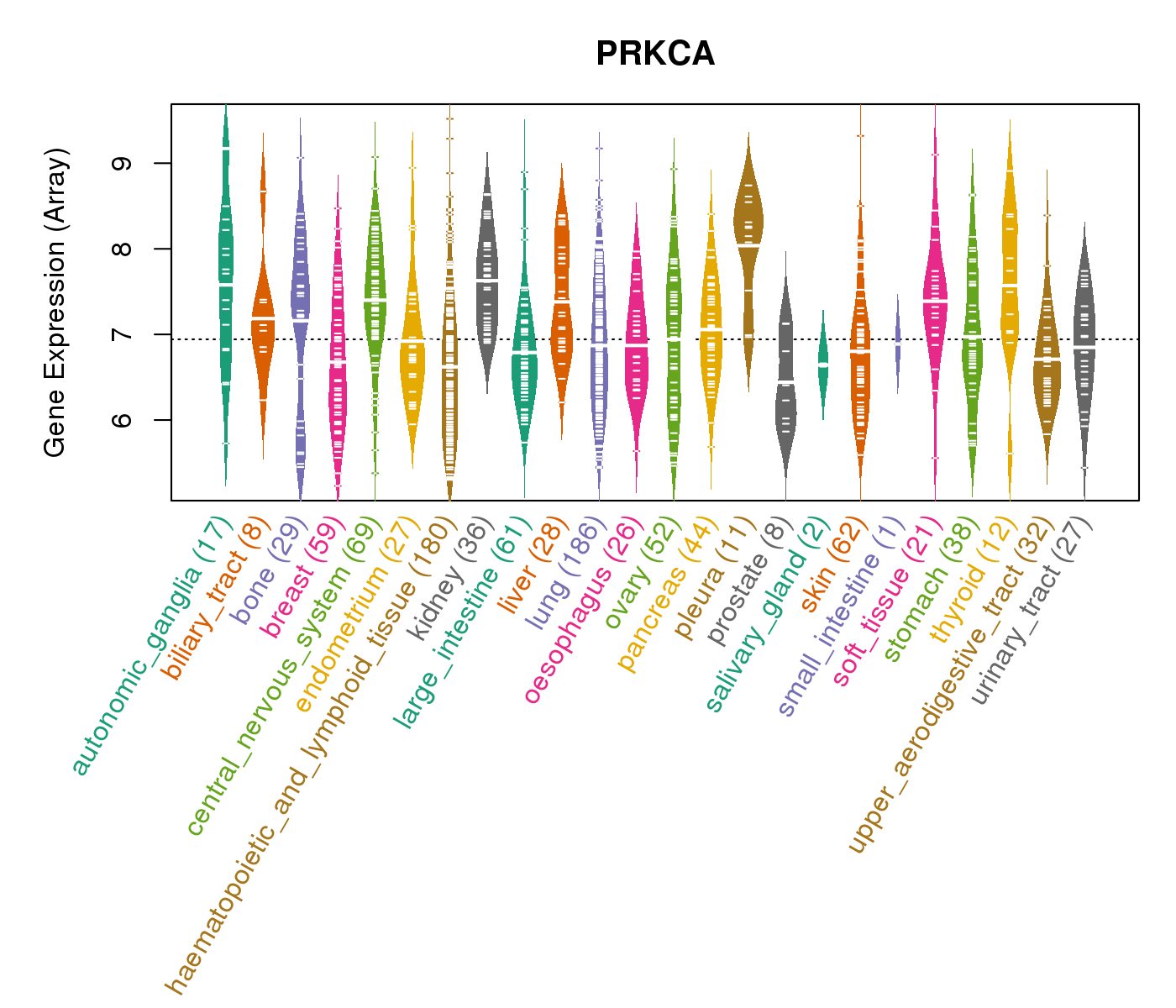 |
| Top |
| *RPPA protein expression data were extracted from TCPA (The Cancer Proteome Atlas). Normalized data based on replicated based normalization (RBN) was used to draw following figures. |
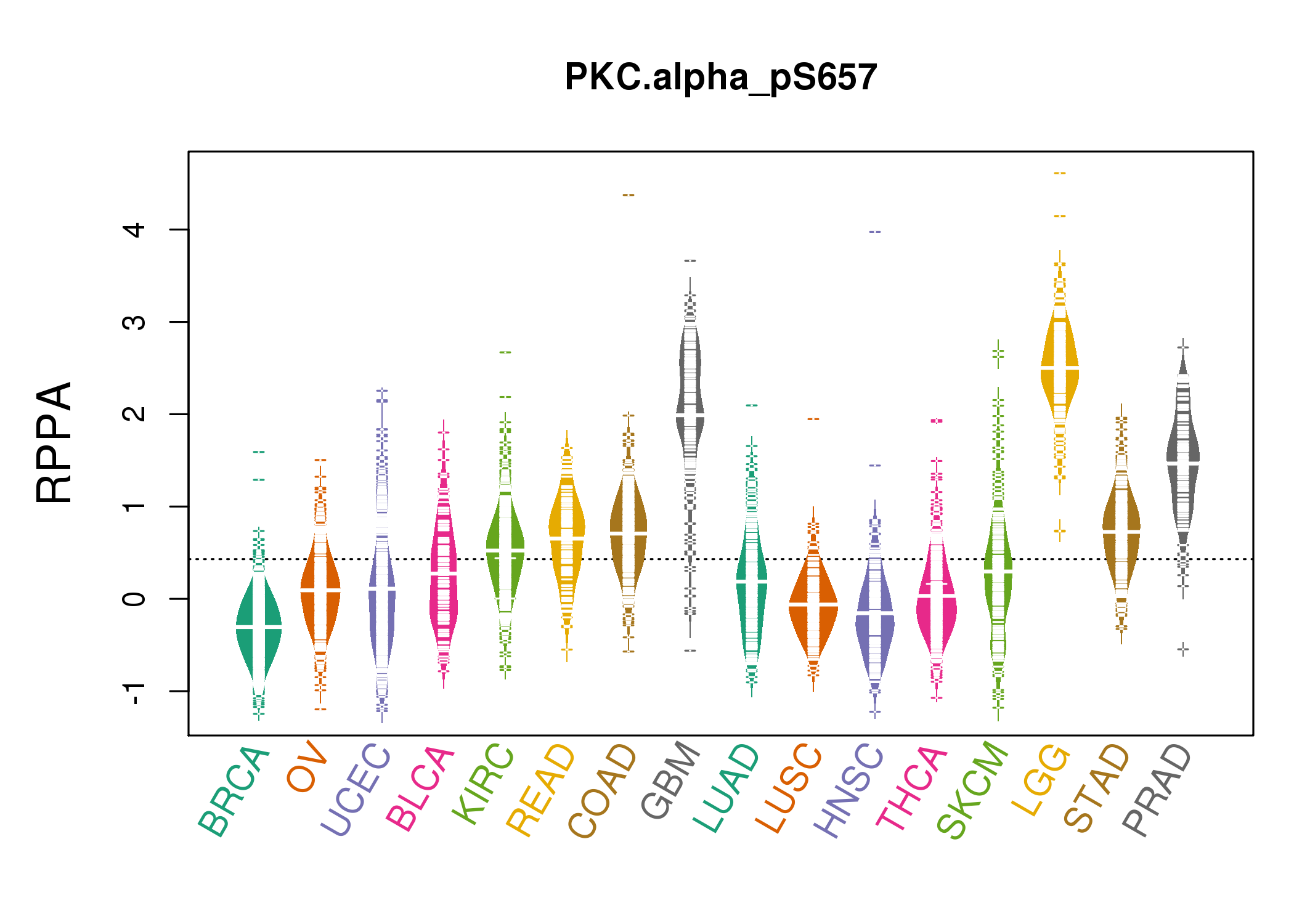 |
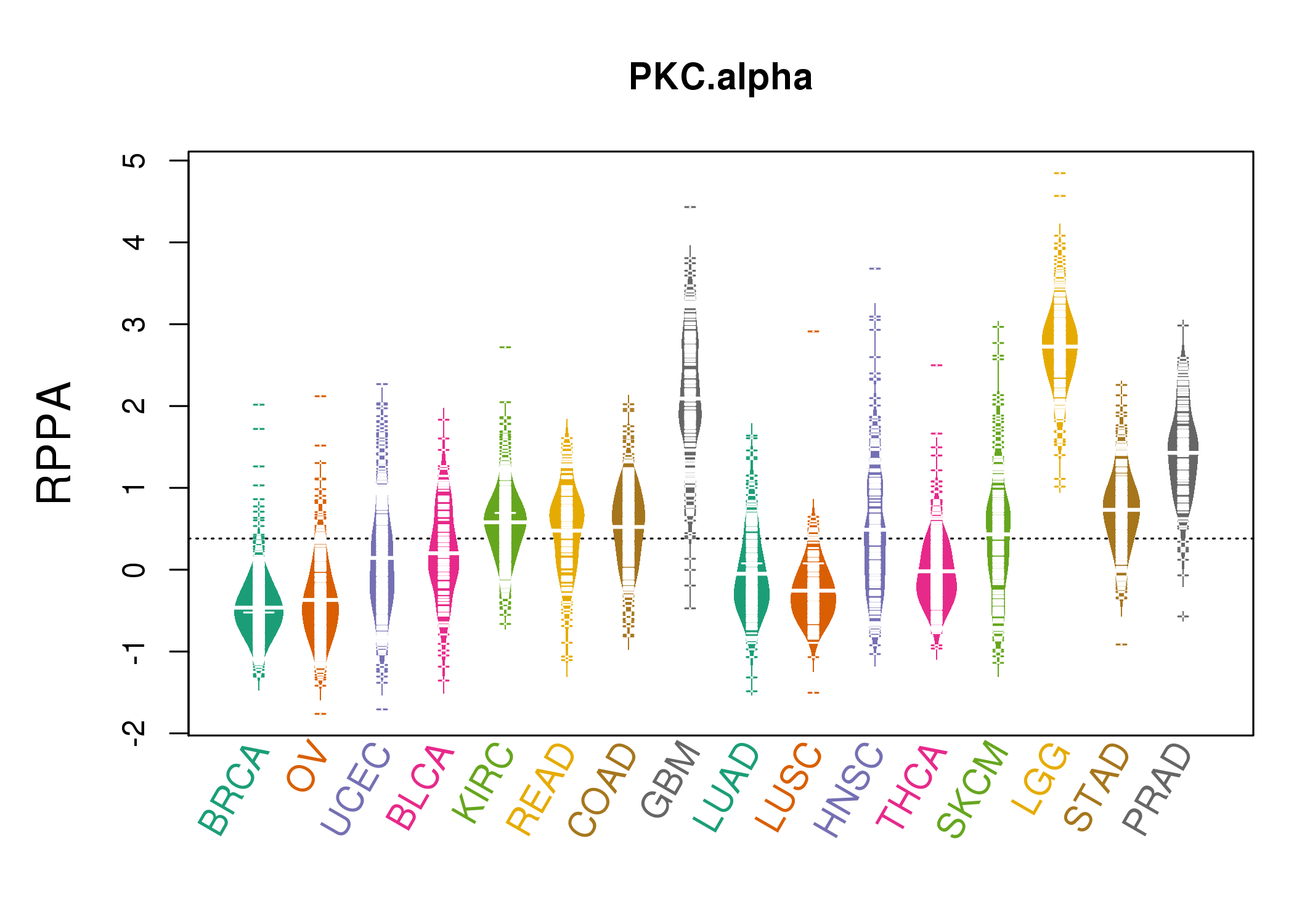 |
| * Normalized gene expression data of RNASeqV2 was extracted from TCGA using R package TCGA-Assembler. The URLs of all public data files on TCGA DCC data server were gathered at Jan-05-2015. Only eight cancer types have enough normal control samples for differential expression analysis. (t test, adjusted p<0.05 (using Benjamini-Hochberg FDR)) |
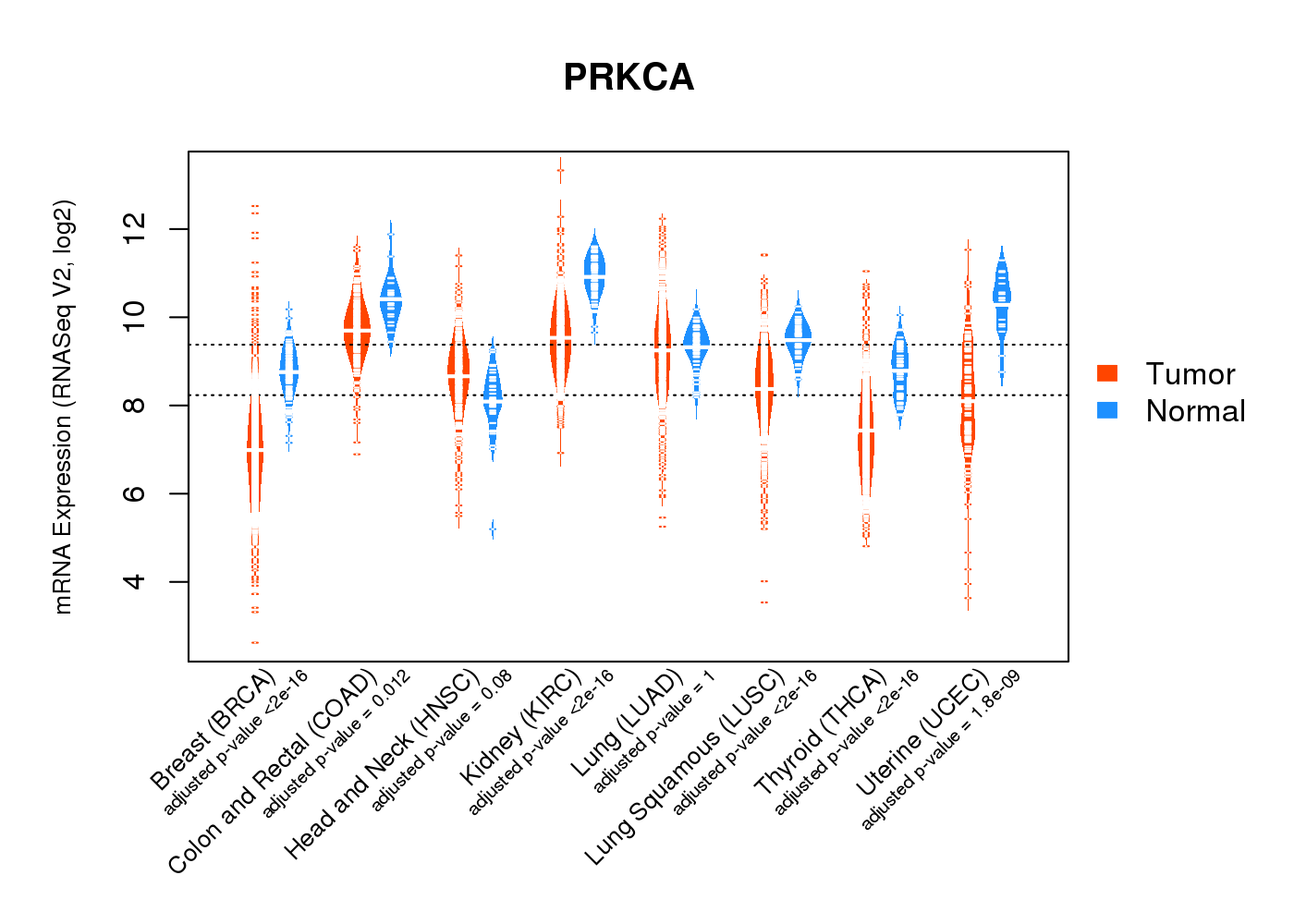 |
| Top |
| * This plots show the correlation between CNV and gene expression. |
: Open all plots for all cancer types
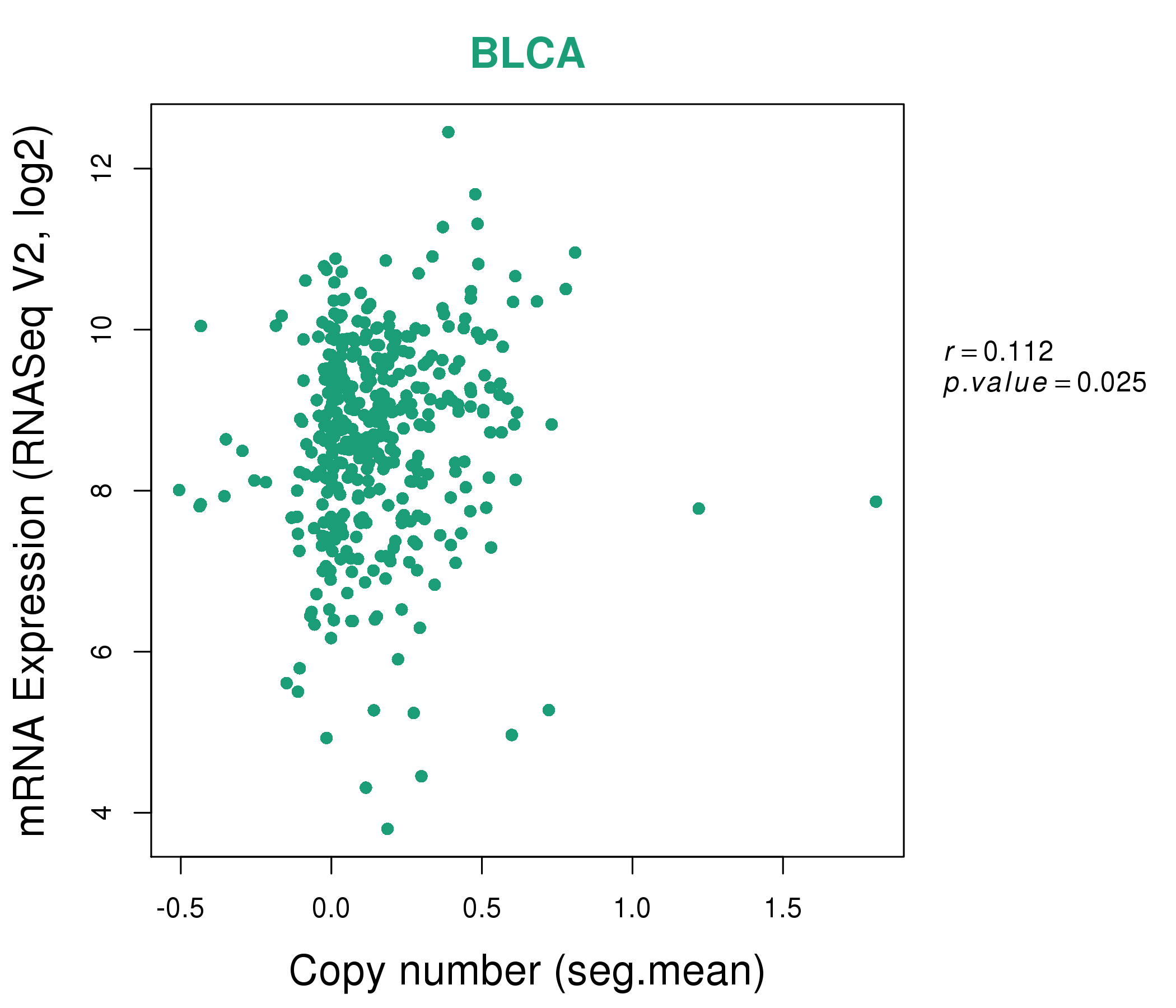 |
|
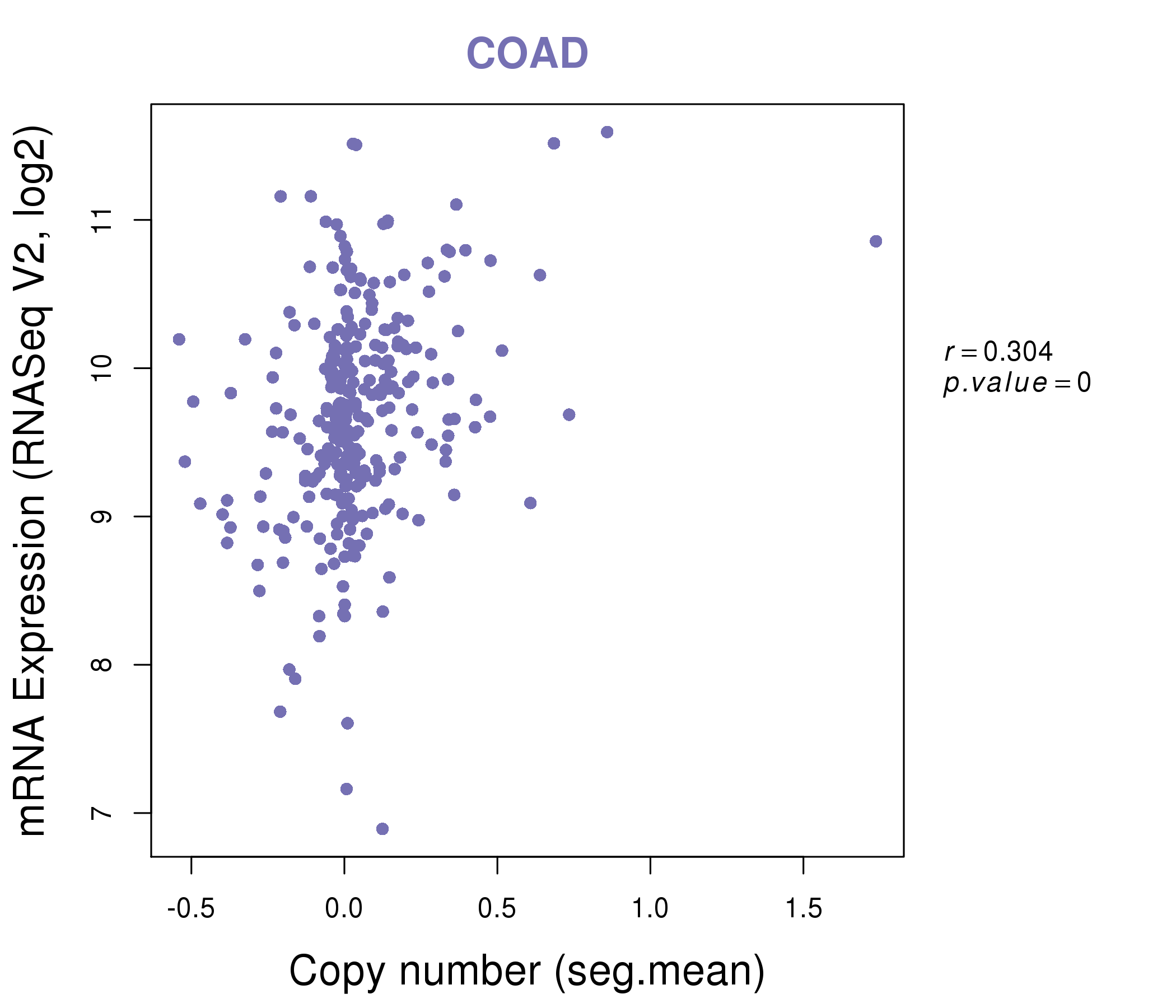 |
|
| Top |
| Gene-Gene Network Information |
| * Co-Expression network figures were drawn using R package igraph. Only the top 20 genes with the highest correlations were shown. Red circle: input gene, orange circle: cell metabolism gene, sky circle: other gene |
: Open all plots for all cancer types
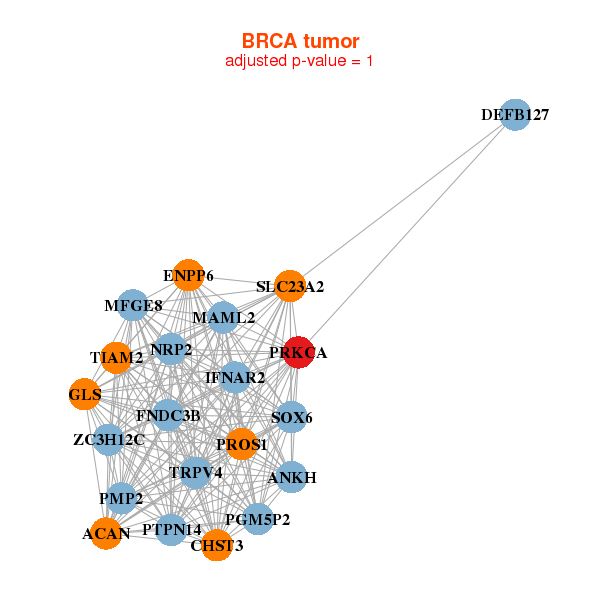 |
| ||||
| ACAN,ANKH,CHST3,DEFB127,ENPP6,FNDC3B,GLS, IFNAR2,MAML2,MFGE8,NRP2,PGM5P2,PMP2,PRKCA, PROS1,PTPN14,SLC23A2,SOX6,TIAM2,TRPV4,ZC3H12C | AKT3,ANP32E,ANTXR1,DPYSL3,GRIN2A,HDAC4,IL7, KCNJ16,KCNJ2,KIAA1024,MOXD1,MUC16,OSMR,PRICKLE1, PRKCA,PROS1,SCN3A,SOCS5,STAC,TLE4,TRPC1 | ||||
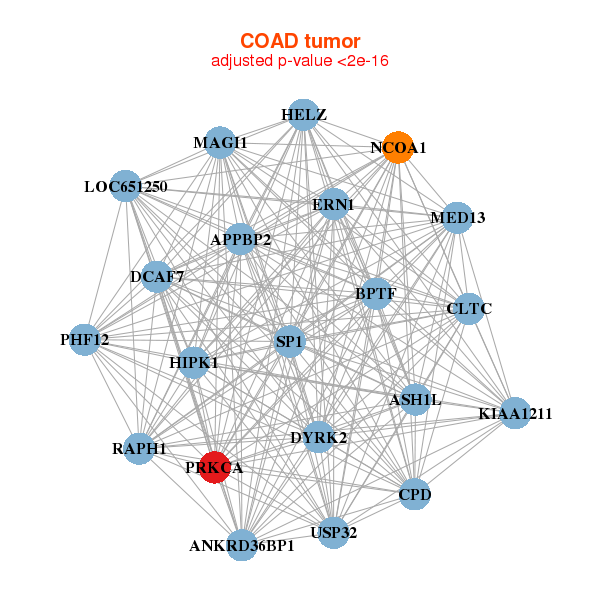 |
| ||||
| ANKRD36BP1,APPBP2,ASH1L,BPTF,CLTC,CPD,DCAF7, DYRK2,ERN1,HELZ,HIPK1,KIAA1211,LOC651250,MAGI1, MED13,NCOA1,PHF12,PRKCA,RAPH1,SP1,USP32 | AKAP6,BNC2,METTL24,DMD,DOCK3,CCSER2,ITPKB, JMY,KCNB1,CTIF,MYH11,NBEA,NRXN3,TENM1, TENM3___TENM1,PIP5K1C,PRICKLE2,PRKCA,SVIL,TLN1,TSPAN18 |
| * Co-Expression network figures were drawn using R package igraph. Only the top 20 genes with the highest correlations were shown. Red circle: input gene, orange circle: cell metabolism gene, sky circle: other gene |
: Open all plots for all cancer types
| Top |
: Open all interacting genes' information including KEGG pathway for all interacting genes from DAVID
| Top |
| Pharmacological Information for PRKCA |
| DB Category | DB Name | DB's ID and Url link |
| Chemistry | BindingDB | P17252; -. |
| Chemistry | ChEMBL | CHEMBL2096620; -. |
| Chemistry | GuidetoPHARMACOLOGY | 1482; -. |
| Organism-specific databases | PharmGKB | PA33759; -. |
| Organism-specific databases | CTD | 5578; -. |
| * Gene Centered Interaction Network. |
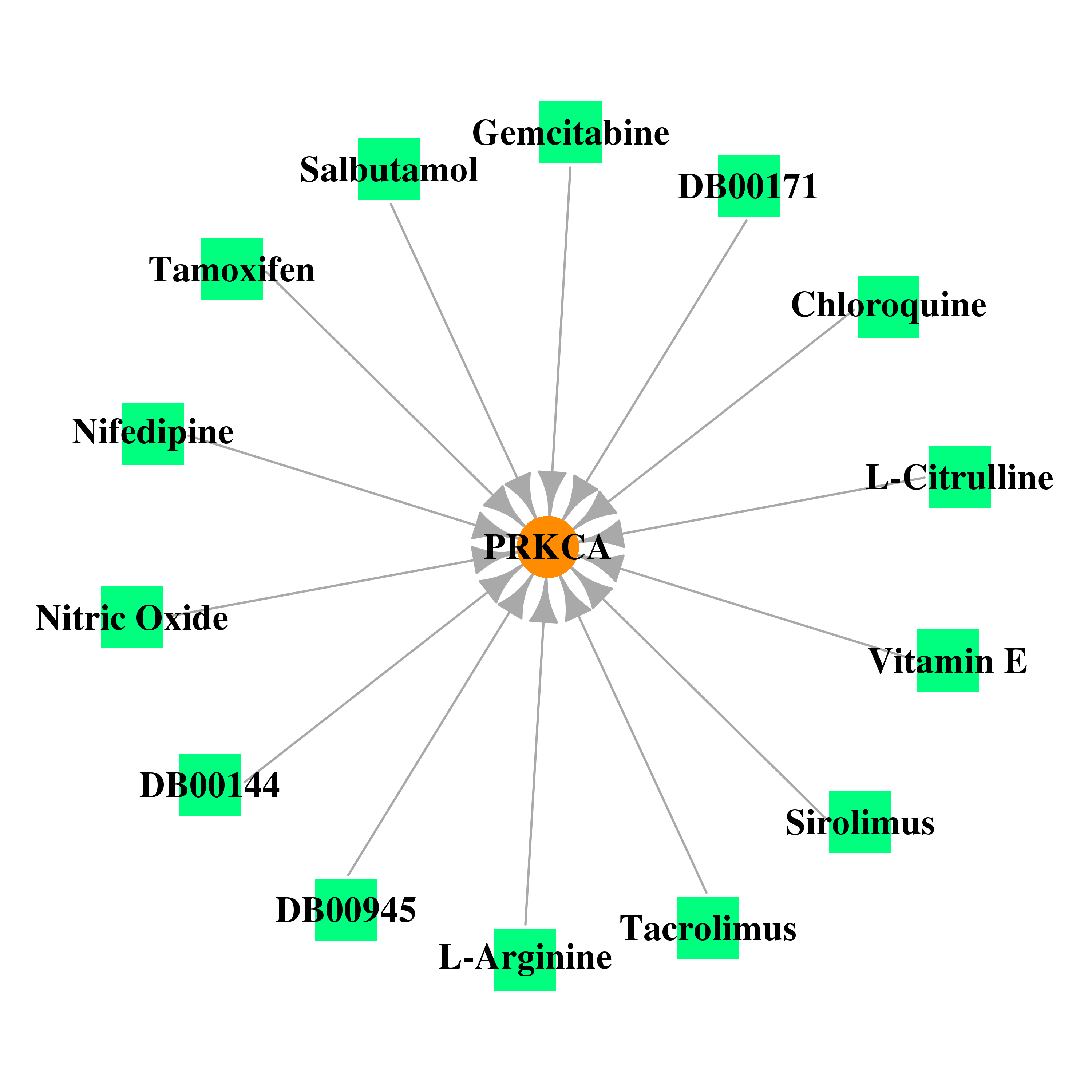 |
| * Drug Centered Interaction Network. |
| DrugBank ID | Target Name | Drug Groups | Generic Name | Drug Centered Network | Drug Structure |
| DB00144 | protein kinase C, alpha | approved; nutraceutical | Phosphatidylserine |  |  |
| DB00163 | protein kinase C, alpha | approved; nutraceutical | Vitamin E |  | 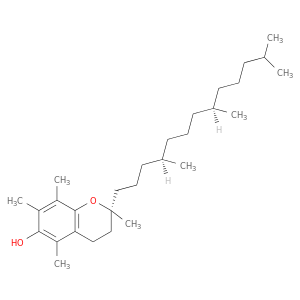 |
| DB00945 | protein kinase C, alpha | approved | Acetylsalicylic acid | 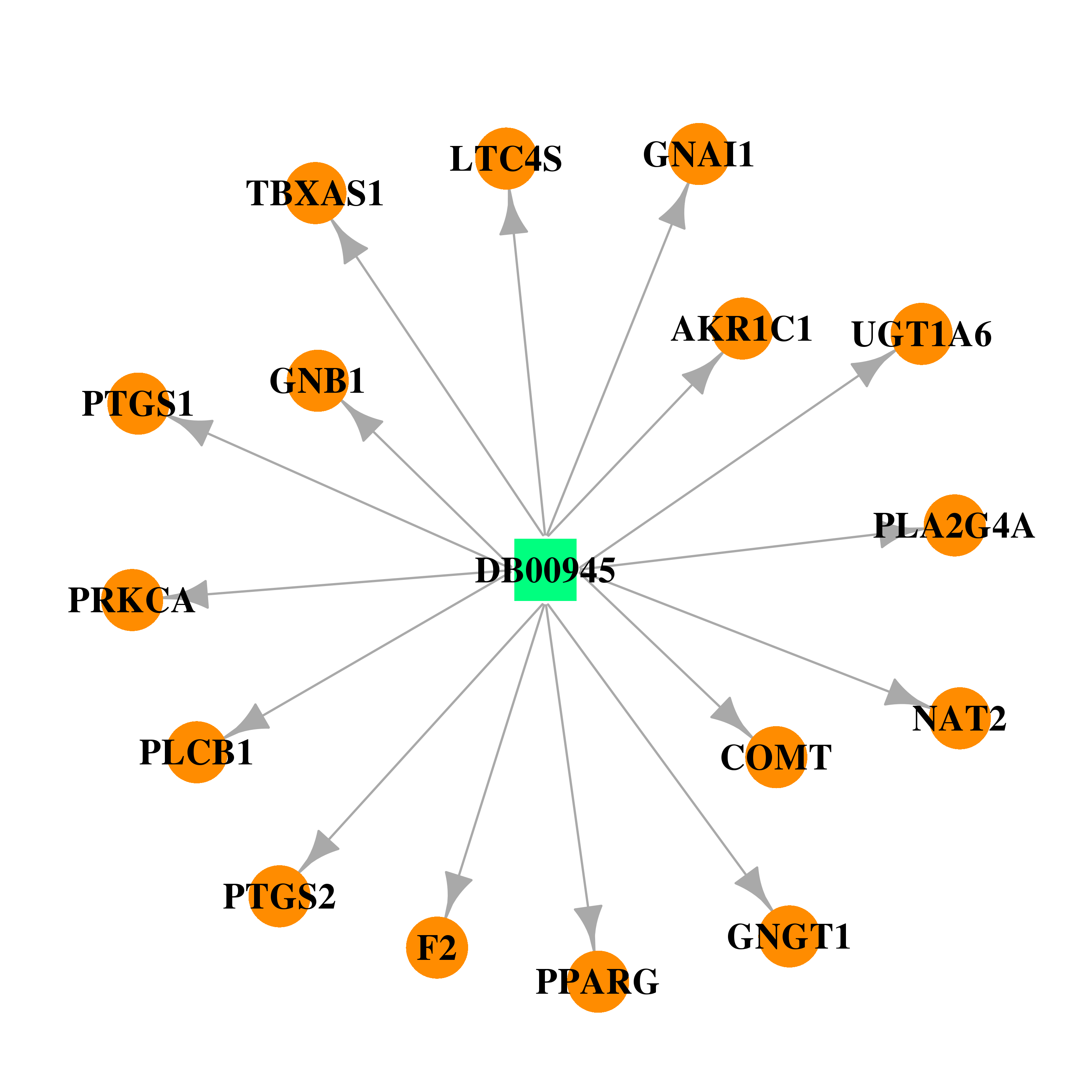 | 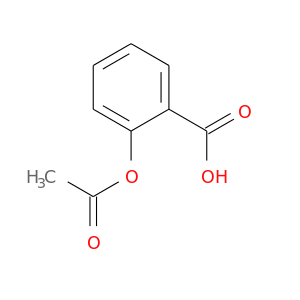 |
| DB00675 | protein kinase C, alpha | approved | Tamoxifen |  |  |
| DB01115 | protein kinase C, alpha | approved | Nifedipine | 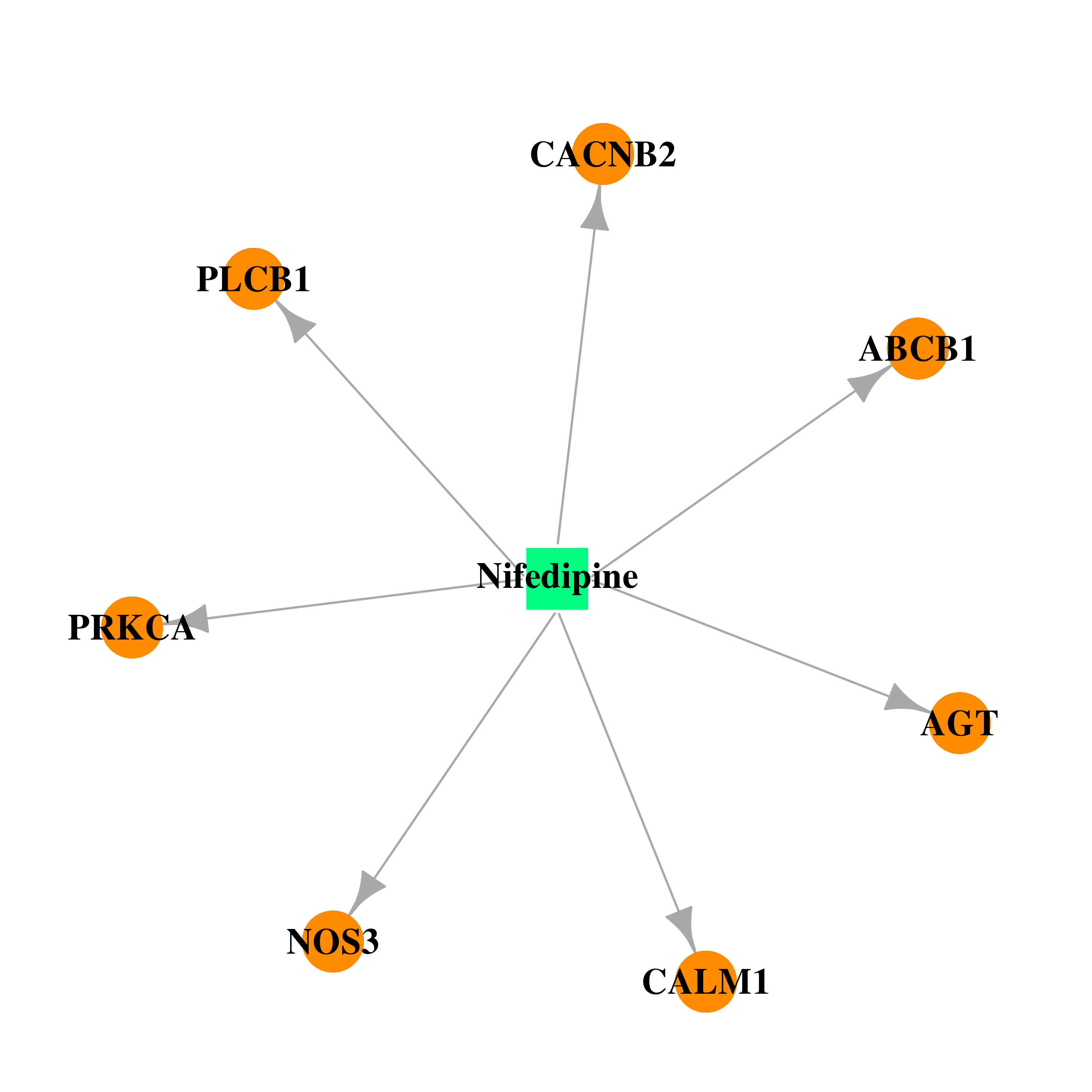 |  |
| DB00877 | protein kinase C, alpha | approved; investigational | Sirolimus | 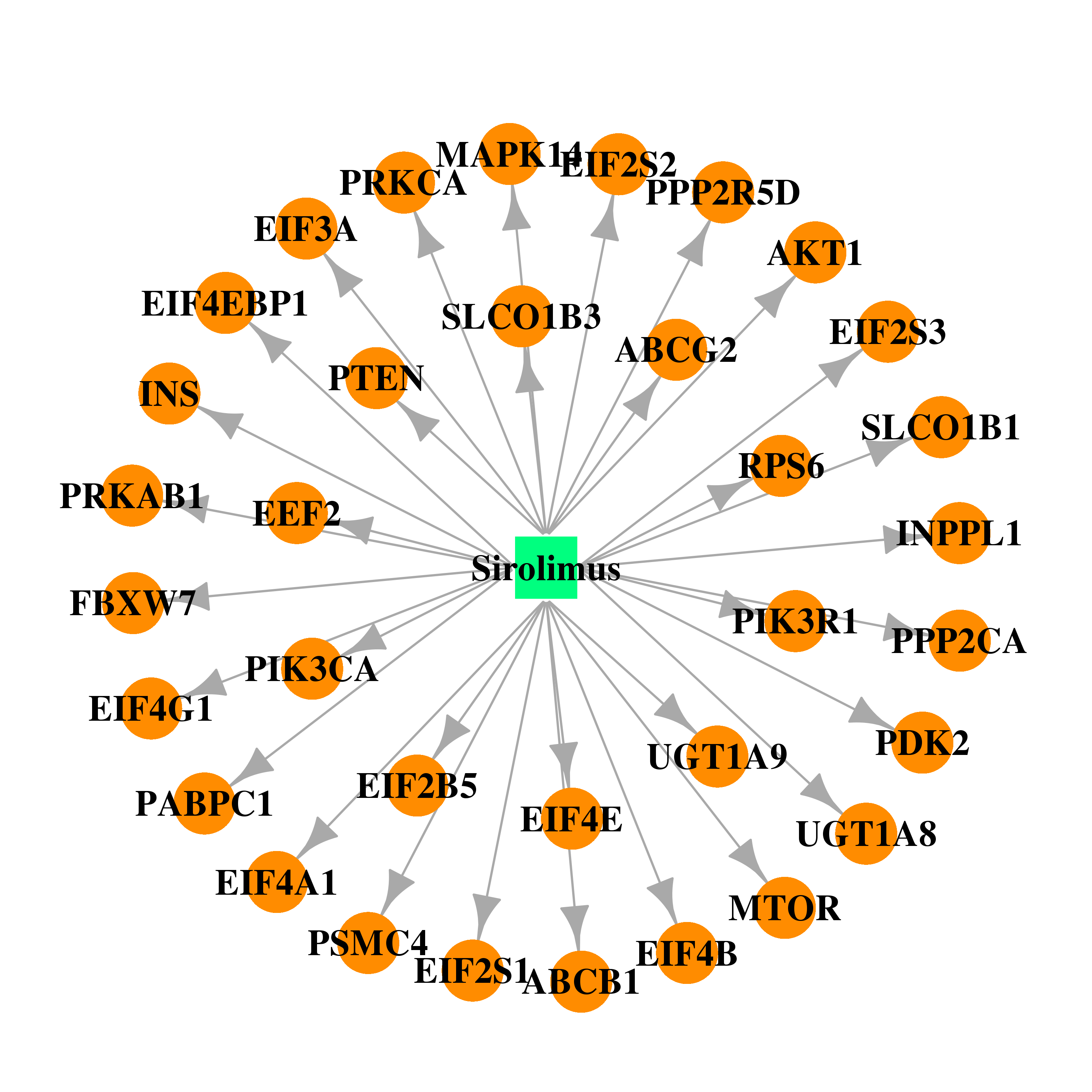 | 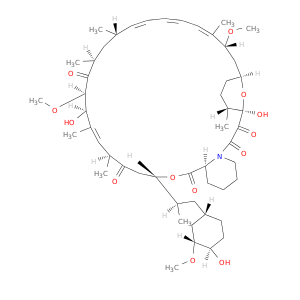 |
| DB00864 | protein kinase C, alpha | approved; investigational | Tacrolimus |  |  |
| DB00608 | protein kinase C, alpha | approved | Chloroquine |  | 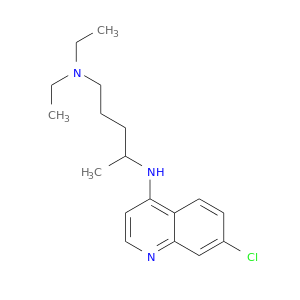 |
| DB00171 | protein kinase C, alpha | approved; nutraceutical | Adenosine triphosphate |  |  |
| DB00441 | protein kinase C, alpha | approved | Gemcitabine | 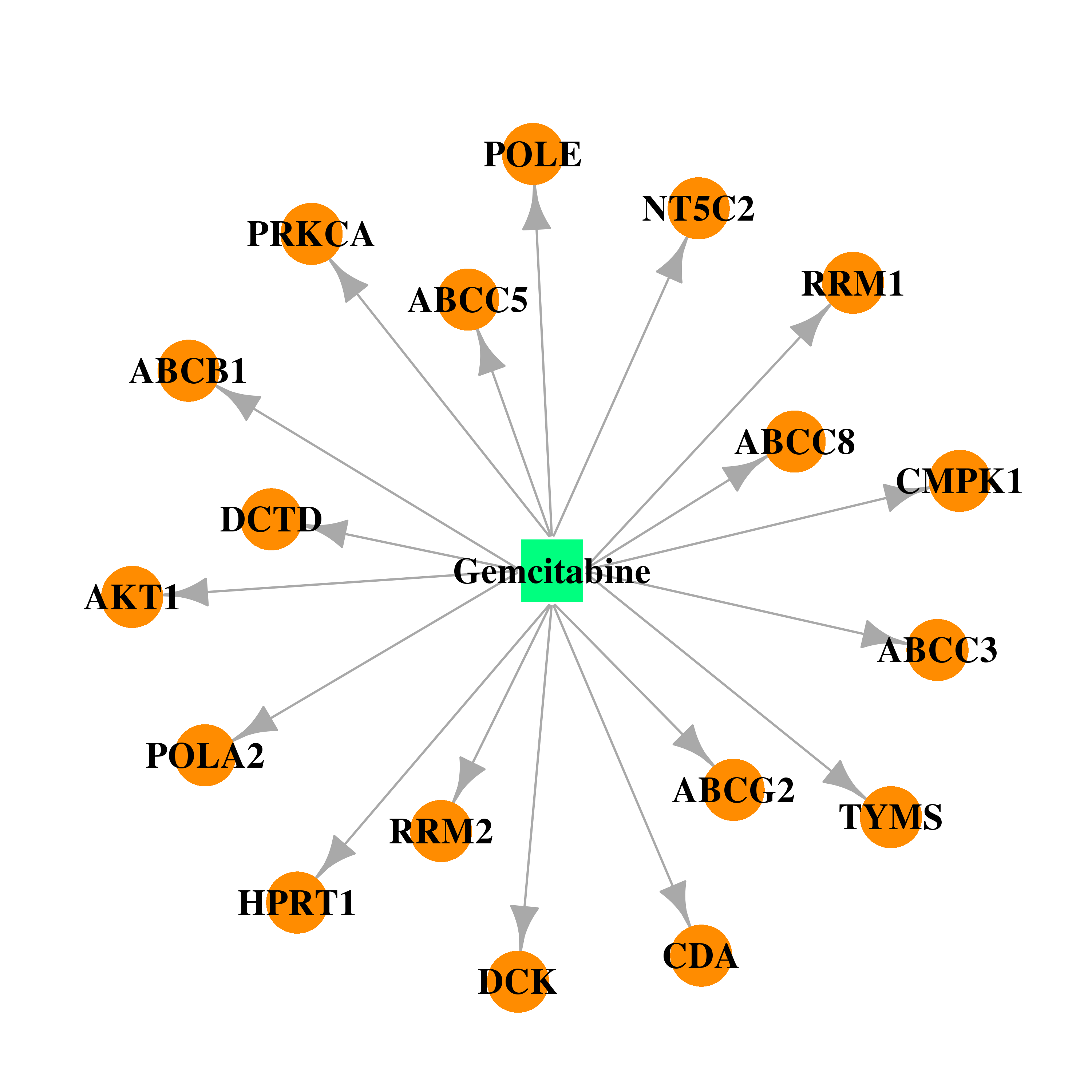 | 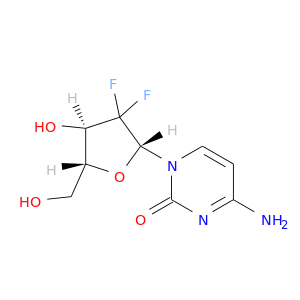 |
| DB01001 | protein kinase C, alpha | approved | Salbutamol |  | 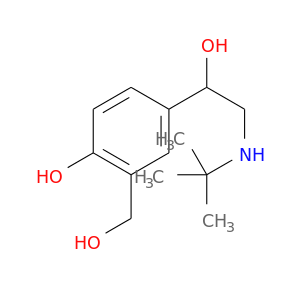 |
| DB00125 | protein kinase C, alpha | approved; nutraceutical | L-Arginine | 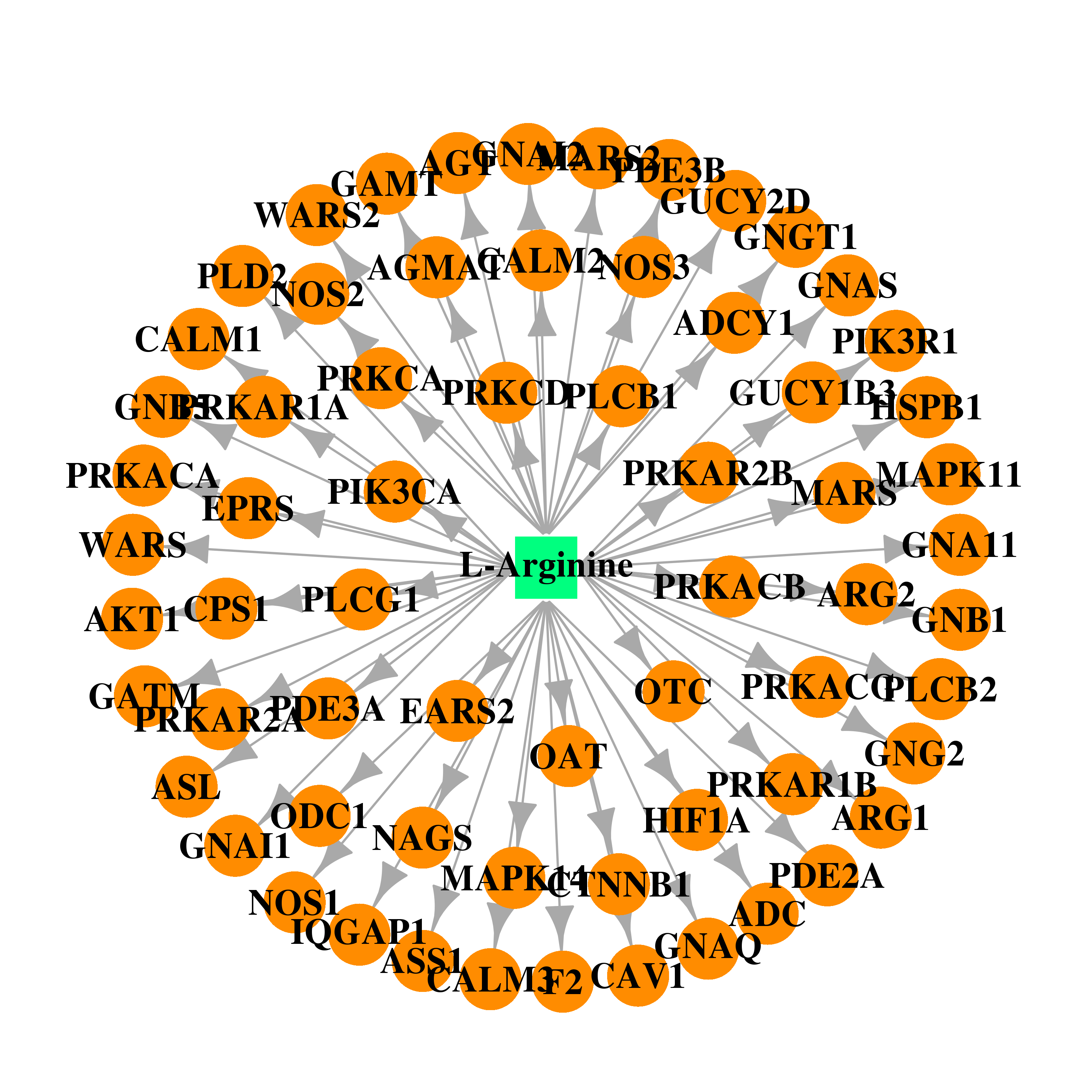 | 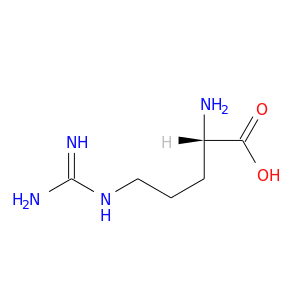 |
| DB00155 | protein kinase C, alpha | approved; nutraceutical | L-Citrulline | 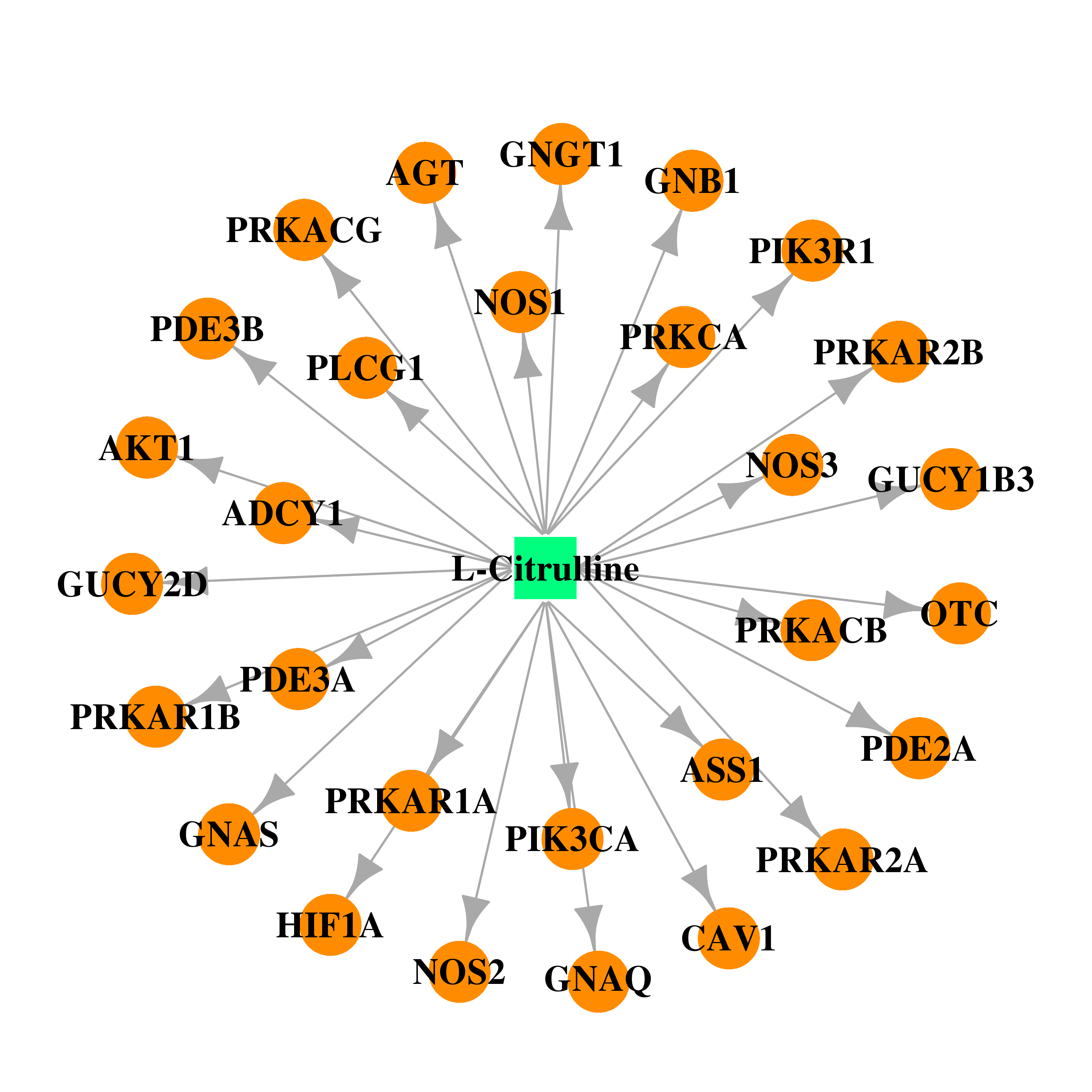 | 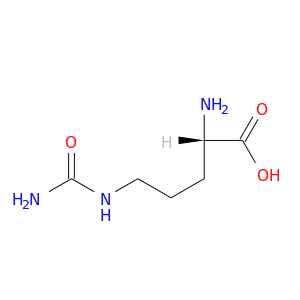 |
| DB00435 | protein kinase C, alpha | approved | Nitric Oxide | 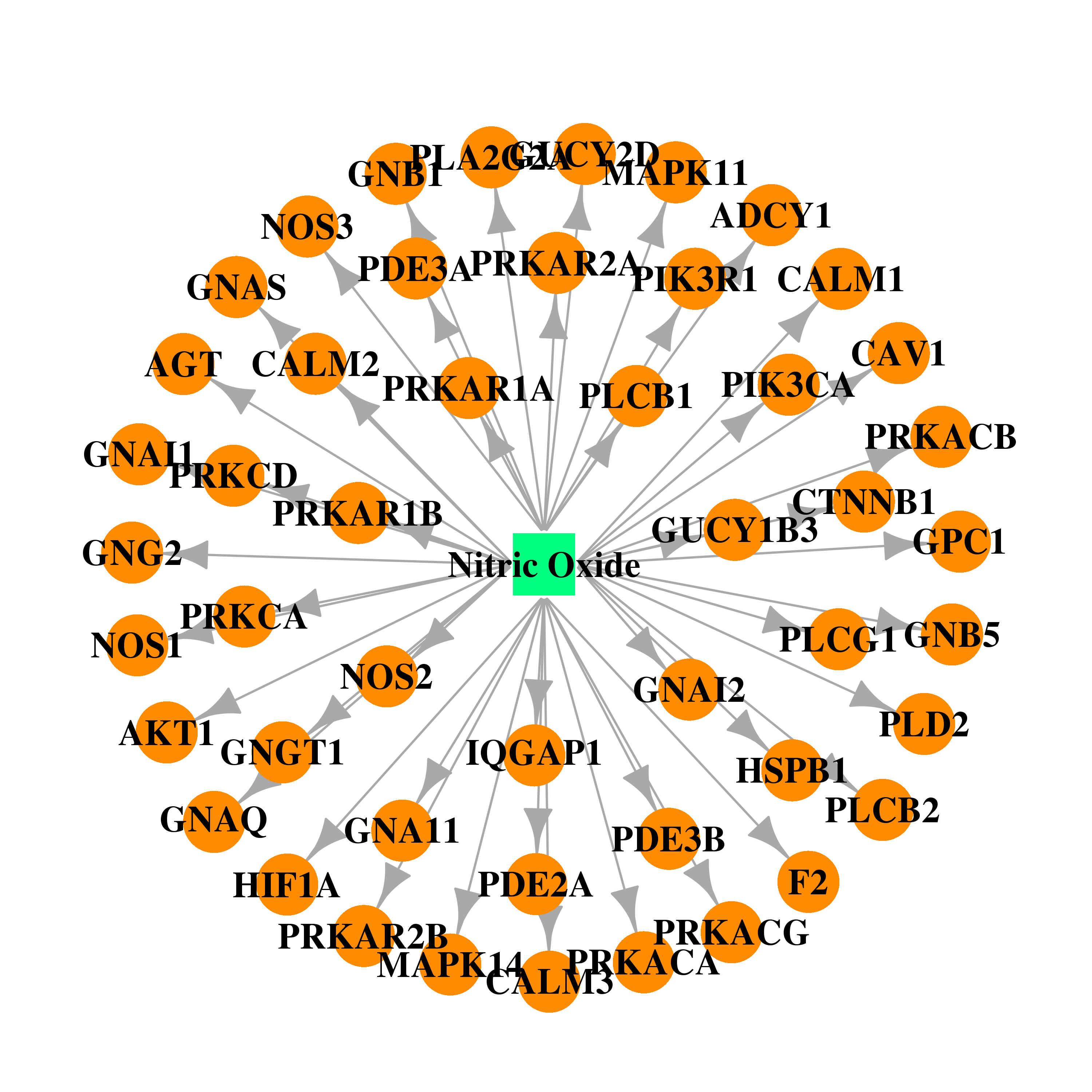 |  |
| Top |
| Cross referenced IDs for PRKCA |
| * We obtained these cross-references from Uniprot database. It covers 150 different DBs, 18 categories. http://www.uniprot.org/help/cross_references_section |
: Open all cross reference information
|
Copyright © 2016-Present - The Univsersity of Texas Health Science Center at Houston @ |






